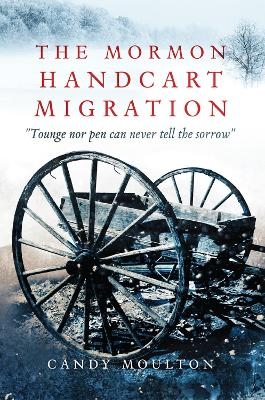
The Mormon Handcart Migration
Tounge nor pen can never tell the sorrow
Seiten
2019
University of Oklahoma Press (Verlag)
978-0-8061-6261-4 (ISBN)
University of Oklahoma Press (Verlag)
978-0-8061-6261-4 (ISBN)
In 1856 the Church of Jesus Christ of Latter-day Saints employed a new means of getting converts to Great Salt Lake City who could not afford the journey otherwise. They began using handcarts. The Mormon Handcart Migration traces each stage of the journey, from the transatlantic voyage of newly converted to Great Salt Lake.
In 1856 the Church of Jesus Christ of Latter-day Saints employed a new means of getting converts to Great Salt Lake City who could not afford the journey otherwise. They began using handcarts, thus initiating a five-year experiment that has become a legend in the annals of Mormon and North American migration. Only one in ten Mormon emigrants used handcarts, but of those 3,000 who did between 1856 and 1860, most survived the harrowing journey to settle Utah and become members of a remarkable pioneer generation. Others were not so lucky. More than 200 died along the way, victims of exhaustion, accident, and, for a few, starvation and exposure to late-season Wyoming blizzards. Now, Candy Moulton tells of their successes, travails, and tragedies in an epic retelling of a legendary story.
The Mormon Handcart Migration traces each stage of the journey, from the transatlantic voyage of newly converted church members to the gathering of the faithful in the eastern Nebraska encampment known as Winter Quarters. She then traces their trek from the western Great Plains, across modern-day Wyoming, to their final destination at Great Salt Lake. The handcart experiment was the brainchild of Mormon leader Brigham Young, who decreed that the saints could haul their own possessions, pushing or pulling two-wheeled carts across 1,100 miles of rough terrain, much of it roadless and some of it untrodden.
The LDS church now embraces the saga of the handcart emigrants - including even the disaster that befell the Martin and Willie handcart companies in central Wyoming in 1856 - as an educational, faith-inspiring experience for thousands of youth each year. Moulton skillfully weaves together scores of firsthand accounts from the journals, letters, diaries, reminiscences, and autobiographies the handcart pioneers left behind. Depth of research and unprecedented detail make this volume an essential history of the Mormon handcart migration.
In 1856 the Church of Jesus Christ of Latter-day Saints employed a new means of getting converts to Great Salt Lake City who could not afford the journey otherwise. They began using handcarts, thus initiating a five-year experiment that has become a legend in the annals of Mormon and North American migration. Only one in ten Mormon emigrants used handcarts, but of those 3,000 who did between 1856 and 1860, most survived the harrowing journey to settle Utah and become members of a remarkable pioneer generation. Others were not so lucky. More than 200 died along the way, victims of exhaustion, accident, and, for a few, starvation and exposure to late-season Wyoming blizzards. Now, Candy Moulton tells of their successes, travails, and tragedies in an epic retelling of a legendary story.
The Mormon Handcart Migration traces each stage of the journey, from the transatlantic voyage of newly converted church members to the gathering of the faithful in the eastern Nebraska encampment known as Winter Quarters. She then traces their trek from the western Great Plains, across modern-day Wyoming, to their final destination at Great Salt Lake. The handcart experiment was the brainchild of Mormon leader Brigham Young, who decreed that the saints could haul their own possessions, pushing or pulling two-wheeled carts across 1,100 miles of rough terrain, much of it roadless and some of it untrodden.
The LDS church now embraces the saga of the handcart emigrants - including even the disaster that befell the Martin and Willie handcart companies in central Wyoming in 1856 - as an educational, faith-inspiring experience for thousands of youth each year. Moulton skillfully weaves together scores of firsthand accounts from the journals, letters, diaries, reminiscences, and autobiographies the handcart pioneers left behind. Depth of research and unprecedented detail make this volume an essential history of the Mormon handcart migration.
Candy Moulton is the award-winning author of eleven books on western history, including Chief Joseph: Guardian of the People and Everyday Life among the American Indians, 1800 to 1900. She lives in Wyoming.
| Erscheinungsdatum | 05.11.2018 |
|---|---|
| Zusatzinfo | 32 black & white illustrations, 3 maps |
| Verlagsort | Oklahoma |
| Sprache | englisch |
| Maße | 152 x 229 mm |
| Gewicht | 544 g |
| Themenwelt | Sachbuch/Ratgeber ► Geschichte / Politik ► Allgemeines / Lexika |
| Geschichte ► Allgemeine Geschichte ► Neuzeit (bis 1918) | |
| Geisteswissenschaften ► Geschichte ► Regional- / Ländergeschichte | |
| Geisteswissenschaften ► Religion / Theologie ► Christentum | |
| Geisteswissenschaften ► Religion / Theologie ► Weitere Religionen | |
| ISBN-10 | 0-8061-6261-9 / 0806162619 |
| ISBN-13 | 978-0-8061-6261-4 / 9780806162614 |
| Zustand | Neuware |
| Haben Sie eine Frage zum Produkt? |
Mehr entdecken
aus dem Bereich
aus dem Bereich
Europa 1848/49 und der Kampf für eine neue Welt
Buch | Hardcover (2023)
DVA (Verlag)
48,00 €
Giordano Bruno - ein ketzerisches Leben
Buch | Hardcover (2024)
C.H.Beck (Verlag)
29,90 €


